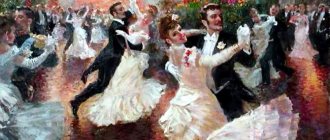The waltz is recognized as an ideal option for dancing in the registry office and the first dance of the newlyweds at a wedding banquet. The wedding waltz is a spectacular and spectacular dance: it always makes an impression on the audience, causes a high emotional intensity and looks great on a wedding video.
Compared to other generally accepted options, it presents some difficulties and requires professional training and the ability to strictly adhere to a given rhythm. But its entertainment and beauty make up for the time spent, and the achieved visual effect justifies all the difficulties of its preparation.
Concert performance in verse
Well, who doesn't love concerts? Since ancient times, people have gathered for interesting spectacles. Contemporaries organize concerts for any occasion or holiday. Especially if a big celebration is approaching: New Year, March 8, May 1, May 9, Mother's Day and others. The host of the event must interest the viewer and prepare for the next performance. To do this, he presents the numbers with a prepared speech. Eyeliner in poetic form is perfect for a concert program:
You won’t be bored at our concert, here the songs are played, the music flows loudly, welcome and clap your hands loudly, a good number has been prepared for you! Attention, dear friends, Now you must yawn, you cannot be distracted. The artists are preparing to go on stage. They have prepared an inspired surprise for you! We are glad to welcome so many guests And so that your soul becomes brighter. For this number we will announce a wonderful, wonderful, wondrous, glorious song! The artists prepared for a long time, diligently, to perform here before you successfully. I hope you will generously appreciate the efforts, with applause and a share of attention! An interesting concert awaits you. You will find a lot of dancing, jokes, songs, Believe me, you will be satisfied. And we will announce the very first issue!
Cheerful introductions from active and positive presenters will put the audience in a good mood.
Dance style
The choice of one dance direction or another directly depends on the preferences of the partners, their temperament and level of choreographic training. Let's look at the most popular styles used when staging a wedding number:
Waltz
This beautiful, romantic and easy-to-perform dance is ideal for a wedding celebration. The lion's share of couples opt for the classic Viennese waltz, which can be mastered in just a couple of lessons. If there is still a lot of time before the cherished date, partners have every chance to bring their act to perfection.
It is impossible not to mention the figured waltz, which differs from its classical counterpart in a more extensive range of movements. Thanks to its amazing lightness and grace, this dance becomes a welcome “guest” at any wedding. It should be performed in appropriate outfits for the occasion: a classic suit and a fluffy ball gown with a crinoline.
Another popular variety of waltz is the boston, characterized by smooth and leisurely movements. He has a special style of performance. When dancing, the couple does not spin, but slowly floats around the hall, measuring the space with long sliding steps. This option is optimal for mature, discreet and balanced partners with refined taste.
We invite you to watch a video lesson of the wedding waltz with exercises and basic movements.
Tango
This dance becomes the choice of bright, passionate and temperamental couples. Due to the abundance of clear rhythmic movements, it will not be easy to choreograph and learn. Therefore, it is worth starting rehearsals in advance
It is important that both partners have a good sense of rhythm and artistry. The dance should be a clear demonstration of the emotions they feel for each other. For the number you need to choose comfortable suits in contrasting colors
The bride can wear a short red or black dress that flatters her figure. The groom does not have to change clothes; it is enough to remove the jacket that restricts movement, and if desired, complement the look with a hat
For the number you need to choose comfortable suits in contrasting colors. The bride can wear a short red or black dress that flatters her figure. The groom does not have to change clothes; it is enough to remove the jacket that restricts movement, and, if desired, complement the look with a hat.
Latina
Rumba, cha-cha-cha, salsa, bachata, reggaeton - these sensual, fiery dances are guaranteed to excite the audience. To perform them masterfully, you will need a good ear and an excellent sense of rhythm. However, you should not refuse this option if one of the partners has some choreographic experience, and the second is only taking the first steps in this direction. In Latin American dances, temperament comes first, relegating skill to the background and opening up wide scope for improvisation. It is recommended to perform the number in comfortable clothes and shoes: a fluffy floor-length dress and stiletto heels can play a cruel joke at the most inopportune moment.
Retro
Crazy rock and roll, slow foxtrot or energetic boogie-woogie will be an excellent solution for a themed wedding. In this case, the costumes and physical parameters of the newlyweds play a huge role. Since retro-style dancing is replete with all kinds of lifts, the groom must have a fairly strong build, and the bride must have miniature dimensions. Also, to perform the number you will need ample free space so that partners can move freely around the hall.
Mix
Perhaps the most difficult and extraordinary option when choosing a wedding dance. Usually it is preferred by bright creative personalities who love to be the center of attention and shock the public with bold experiments. In this case, the newlyweds will have to not only master various dance styles, but also make a suitable musical cut, work out the images in detail, etc. It is necessary to start rehearsals as early as possible so that the partners can accurately learn all the movements and connections.
TOP 10 instrumental melodies
Instrumental melodies receive special attention and preference at celebrations, as they are lyrical and touching. It is enough to listen to just one song to feel it to the end
And if you also look at the accompanying dance, you can be completely moved to tears.
- Stas Mikhailov - “Who created you like this.”
- Violin – “Love Story”.
- Fausto Papetti – Abrazame
- Dave Koz – Faces of the heart
- Candy Dulfer – Wish You Were Here
- Heal the World – Michael Jackson
- Joe Satriani – Heartbeats
- Julian Sas – Blues For J
- Benny Golson - Autumn Leaves
- Dexter Gordon - Cry Me A River
If the groom decides to choose a foreign musical composition, then he urgently needs to familiarize himself with the translation and carefully read the text. It is necessary to select a text that will be appropriate to the dance situation. Of course, you should immediately reject options about broken love and heart, difficult fate.
Video lesson: wedding dance performance
When searching for a suitable composition, it is sometimes difficult to decide; you don’t always like what is offered. Therefore, be patient and prepare for the fact that this will take a considerable amount of time. Choose a dance that will not be difficult to perform, understandable in movements and interesting for your couple. As a visual example, watch the short video lesson attached below on how to successfully perform a wedding first dance:
If on your wedding day one of you forgets some movement, don’t worry, just surrender to the mutual feeling of love and dance your first dance as your feelings and the peculiarity of the moment tell you. Tune in to the wave of your beloved partner, look into those tender eyes and don’t think about anything other than enjoying the present moment of life. Create happiness and love for each other in every moment and you will succeed!
Important points
- When staging a number, it is necessary to take into account the features of the room in which the celebration will take place (ceiling height, arrangement of tables, presence of columns, flooring material, etc.). If possible, it is recommended that the dress rehearsal be held directly in the banquet hall or restaurant.
- It is important to discuss the shooting angle with the photographer and operator in advance. Otherwise, young people risk being photographed from the back or only in profile.
- Don't delay your wedding for too long. 2-3 minutes will be more than enough for a couple of beginners. A dance that lasts too long will not only tire the newlyweds, but also bore the guests.
- During the performance, partners should relax as much as possible and discard unnecessary worries. After all, excessive excitement can negatively affect the quality of the dance. If one of the young people forgets the movements, it would be appropriate to resort to improvisation. Stopping in the middle of the dance is unacceptable, so as not to disrupt the performance and not let your partner down. Since guests are seeing the room for the first time, they may not notice a slight hiccup.
Thus, the process of staging a wedding dance requires taking into account many nuances. Practicing movements, finding a suitable musical composition, choosing costumes and comfortable shoes - all this takes a lot of time and effort. On the other hand, joint activity in preparing the act brings partners closer, teaches them mutual understanding and adds cohesion to the couple. Only by learning to feel each other perfectly will the newlyweds be able to perform an impeccable wedding dance.
Soap bubbles show
At children's parties, the “Soap Bubbles Show” becomes very popular. Transparent balls soaring into the air delight babies, older children and even adults. An amazing number can be announced as follows: They fly up, to the delight of the children,
Such unusual transparent balls. They will circle you in a wonderful round dance, try to catch up and burst them! It’s not rain, not snow, not hail, Everyone is happy to catch them, How amazingly they fly, Softly settling on the ground. And the kids are very happy when the soap bubble spins. A miracle came out of water and soap. You inflate a balloon and it will fly. Clouds are flying from soap bubbles, run after them, burst quickly! Soap bubbles are an excellent show for young children that will decorate a children's party.
What to consider when choreographing a dance
Room.
A dance with high supports, typical of Latin and rock and roll, can be ruined by low ceilings in the room. Thus, the bride will not be able to jump into the groom’s arms, which will lead to not all elements being completed.
Floor. The material from which the floor of the hall is made is also of great importance. It will be very difficult to navigate if it is tiled. In this case, you should think about comfortable shoes without heels, which are not suitable for all dance styles.
If the flooring is parquet, then you can safely take figures from Latin, waltz, and retro. But since it can creak, it is better to rub the shoes of both partners with special compounds. Also, when dancing on it, there is a high risk that the newlyweds will lag behind each other due to poor gliding.
Shoes. It is better to exchange the bride's wedding shoes for a spare, stable pair. These can be ballet shoes, models with wedges or heels.
To avoid injuring your partner due to inexperience, it is better to avoid high heels. You should not choose them even when there is a small difference in height between the newlyweds, so that the partner does not end up taller. In this case, it will be very difficult to perform complex choreographic elements.
Guests. The location of the guests must also be taken into account. If the tables are placed on one side, then it is unacceptable for the couple to turn their backs to the audience. Then the steps should be taken from left to right or in the other direction. When placing them around the entire perimeter of the hall, you need to select circular movements so that everyone can see the bride and groom.
Photo and video shooting. Don’t forget about the work of a videographer with a photographer. In order for them to have the opportunity to capture the heroes of the occasion in an interesting and high-quality manner, they need to know in advance about their location in the banquet hall. But usually photography takes place from the right or left side.
Duration. A wedding dance usually lasts no longer than 2-3 minutes. For untrained performers, spinning on the floor for longer will be difficult - they will experience shortness of breath and begin to sweat. It won’t take long for the wedding dress to deteriorate, the style of which also plays an important role in the staging of the wedding dance.
Cloth. If the outfit is too loose, then you can get tangled in it and fall. It will also be inconvenient to support the groom when the bride needs to be circled and picked up.
However, too narrow long models are not an option, since it will be difficult to move freely around the hall in them. This way you won’t be able to repeat either the graceful swings of your legs or the sharp transitions in a waltz. In this case, the dance risks turning into standing still.
A short wedding dress gives complete freedom of imagination, allowing you to fulfill absolutely all the planned elements.
Preparation stages
After the main parameters that determine the nature of the wedding dance (see) have been determined, the newlyweds need to:
- choose a time and place for training. It is desirable that the conditions of the site approximately correspond to the future dance floor. For normal preparation, at least three to five half-hour rehearsals will be required for dancers of average training, 5-8 rehearsals for poorly trained people;
- choose a dance pattern and break it down into separate elements. The same goes for musical accompaniment. Each fragment-link is learned separately, then they are combined into a single whole;
- conduct at least one rehearsal in clothes as close as possible to wedding clothes. You should take into account the height of the heel, the length and width of the bride’s skirt, and the comfort of the groom’s suit.
The last rehearsal is an excellent opportunity for the bride to break in her wedding shoes or finally make sure that they need to be replaced with a more comfortable model.
A comic skit or number
It's not just KVN shows that have funny performances. A comic skit or humorous number can become part of a concert program or a holiday scenario. Before the number of the humorous genre, the presenter pronounces the appropriate summary.
Now in front of you, with funny words, the artists will tell some kind of true story. So that you don’t yawn, don’t get bored at all, and your cheerful laughter floats through the hall. Laughter lifts the mood, Ah, a joke cheers the heart, A performance is ready for you, Where humor and enthusiasm reign. Do you want to laugh and hold your bellies? Roll around laughing? And check out the jokes? We will show you the number. Forget about napping, He will be able to amuse you perfectly. Now. They say that laughter prolongs life, Yes, and each of us knows this. So let's get healthy, Let's unite with loud laughter. Presents you with a wonderful scene. For health - very useful For the sake of a joke and your amusement For a cheerful loud laugh Let's show an unusual number It would be indecent not to laugh. Goodbye yawning and boredom! It's time for some fun laughter! Our room will be decorated with smiling faces, It will be a funny tale now.
Funny eyeliners set the audience in a positive and necessary mood. They relax in advance in anticipation of a comic scene or humoresque.
How to dance a wedding dance: taking into account the nuances
A wedding dance is not only about the movements of two people, but also about many different details that should not be forgotten.
- Size of the dance floor. Before you come up with a wedding dance, go to the banquet hall and evaluate how much space you will have to swing. If there is little space, you should try to select figures without quickly moving around the room. The Viennese waltz, for example, involves moving in a circle. If there is not enough space, you may hit some of the guests.
- Spectators. Consider where the guests, videographer and photographer will be during the dance. If the guests are on one side, your dance will be facing them, but it happens that the guests are sitting in a circle, then you need to make sure that you will not always have your back to someone, you need to turn around alternately.
- Duration of the dance. It is advisable that the dance last no more than 3 minutes. This will make it easier for the young people too, not to come up with too many moves, and the guests won’t get tired. If the song you choose is too long, shorten it at the chosen point or simply ask the DJ to cut it off at the 3 minute mark.
- Physiology of a couple. Not all couples have the ideal combination of height and body type. If you have special features, they need to be taken into account. For example, for a couple where the bride is much shorter than the groom, you can use figures where the groom bends or crouches slightly, and the bride remains standing. Supports can also be used, which should not be done for couples where the bride is slightly larger than the groom.
- Wedding Dress. Not every dress style will be suitable for the chosen dance. During rehearsals, try to wear clothes that are as similar as possible to your wedding outfits. Then it will be easier for you to think through your movements.
- Start choreographing your dance no later than 2 months in advance for your wedding. Rehearsals must be regular and last at least an hour. Then your dance will be well thought out, and you will be sure that you will not forget anything.
Dance examples from the Internet: learning from our mistakes
If we paraphrase the saying about the amount of drink (“I took” much less than I wanted, but much more than I could) in relation to this speech, you get the following:
- The guys tried really hard;
- The production is difficult for their level. And even with fast music;
- The costumes are almost perfect, with the exception of the partner's flipper-like shoes
The production is almost completely copied from the cult film Dirty Dancing. The newlyweds performed it relatively well. Although it would be better to distribute the training time a little differently:
- More time to master the basics;
- It’s easier to make the connection, but still achieve professional performance.
- And so it turned out to be a dance with pretension, but of a weak level
Not a bad performance. If only the bride had a stylish suit, it would be absolutely perfect!
And this is the very unattainable ideal of a partner that any bride can only dream of. He literally lives for dance (Cuban, no less!), so minor flaws in his partner’s costume are simply not noticed. Because the partner overshadows everything! Although it is more correct when the partner leads the lady in such a way that she looks like a beauty queen. Although it feels like all this happens thanks to the partner. Like in the movie Dirty Dancing.
Dance simply, but with love and confidence! And then any salsa will satisfy you!
Forever young waltz for newlyweds and guests
They say that in the good old days, when time flowed slowly and people had enough time to communicate, wedding celebrations were modest but sincere. And it doesn’t matter that instead of a fancy stereo system (or a DJ with a set of sound-reproducing equipment), a self-taught accordionist or an amateur orchestra created the mood for the guests. The newlyweds, their families, friends and loved ones had enough music to enjoy dancing at the celebration. Because almost everyone knew how to dance.
Today, a person who can dance well is becoming a rarity. The proposed dance scheme will allow future spouses not only to feel confident on the floor, but also to act as dance stewards, organizing for friends and guests first a kind of express course in waltz, and then a synchronized and spectacular performance of the learned material (today it is called a flash mob ). The movements of the dance number (unofficial name “50 grams”) are so simple that they can be mastered in literally half an hour (especially after 50 grams of good cognac “for courage”).
Quickly learn the waltz in a couple of days
The video lesson “Wedding Waltz” proves that you can learn how to perform a delightful wedding dance even in a short time. This video lesson will help out the bride and groom who did not have time to learn the wedding dance, and there is very little time left.
He will contribute to the study of a wedding waltz of lesser or greater complexity, and will tell you about the necessary details in the dance.
Armed with the “Wedding Waltz” video lesson, the bride and groom can learn for free in a few days the most suitable way to dance the waltz and delight their guests with a polished performance of this beautiful dance!
Summary of ditties in the script
Chatushka is a funny, mischievous song that is suitable for any celebration. The ditties are full of gentle criticism, humor, funny moments and a cheerful motive. Chastushki are performed for any occasion. They can be applied to the New Year, Anniversary or Birthday, or to another holiday. A number of ditties perfectly relieves the situation and relieves boredom. They lift the mood, charge the audience with optimism and fun. Before performing the ditty, the host introduces the artists with an introductory poem.
There is no song more fun for the visual ear, Which will cheer you up and make you laugh, Like a catchy ditty, It will sound for you today! A cheerful ditty rings like a rattle, There are jokes and enthusiasm in it, A set of funny words! And now stop sitting in despondency. Let's sing funny songs. The old lady plays and dances with an accordion. When ditties are sung loudly. Our laughing people will perform before you, They will dance merrily and sing ditties! Something has become a bit boring At our feast To make it feel “hot” Let’s binge on ditties. Now a playful song will sound for you, Lots of jokes, funny phrases in a small ditty. We allow you to sing along and laugh loudly, it is forbidden to get bored and yawn on the sidelines.
The ditties refer to a fun number. A funny lead-in to the ditty will set the audience up to listen to a funny song. Until the first rollicking melodies of the ditty, the audience present at the concert will feel a surge of cheerfulness and pleasant anticipation.
About the waltz very briefly (“galloping across Europe”)
Several European countries - France, the Czech Republic, Germany and Austria - contributed talent, hands and feet to the birth and development of the dance. The debate about where exactly the eternally young waltz was born continues to this day. Those interested can read about it here: https://tango-beregovo.blogspot.com/2015/05/blog-post_73.html
The fast waltz (better known by its romantic name, Viennese) is a relatively simple dance. However, its speed often becomes an almost insurmountable obstacle for beginning dancers.
The British, as usual, changed the European waltz almost beyond recognition. Its main difference from the Viennese one is the almost twice as slow rhythm and the abundance of complex, spectacular figures. More information about the slow waltz can be found here https://tango-beregovo.blogspot.com/2015/05/blog-post.html.
You are offered a simple pattern, which is performed to a moderate rhythm (not as fast as the Viennese waltz, but not as slow as the English one). In addition, the main step of the dance sequence has been specially simplified so that untrained people can quickly master it.
Confident Leading
In pair dances, the roles have long been distributed - the partner leads, the lady follows. Accordingly, the partner takes the lady by the hand, and not vice versa (which is often the “sin” of overly emancipated persons).
While performing dance numbers and changing positions, the partner intercepts the lady’s hand in different ways to make it more convenient to guide her. Partners need to try not to grab onto each other like a life preserver. So it won't be long before injuries!
At the end of the preparation, it is advisable to conduct several dress rehearsals in wedding suits and shoes (it is advisable to immediately eliminate all noticed shortcomings), and certainly in the presence of several spectators. After a series of rehearsals, the newlyweds will feel more free at the real performance.
Here is the entire composition:
And here is a detailed analysis of it with all the nuances:
How to organize rehearsals correctly: useful tips
Here are some useful tips to help you organize your rehearsals correctly:
No more than 3 days should pass between classes, otherwise the memorized movements may be forgotten.
in shoes and clothes
If you really want to learn how to dance beautifully, then you must work on your mistakes. Each rehearsal should be videotaped. And the next lesson should begin with the analysis of the video - steps, turns, lifts, eliminating the mistakes made
At the same time, it is very important to imagine that every training session is an appearance on stage.
These are the features of independent preparation of a wedding dance, if taken into account, you will be able to adequately cope with the task.
Choice of services
Friends dancing at a wedding: videos and ideas
Usually neither the guests nor the newlyweds get bored at a wedding. However, the dance of the groomsmen or bridesmaids will contribute to creating an atmosphere of celebration and fun, and will also be an excellent gift for the newlyweds.
- 12 photos
Touching moment: father and daughter wedding dance
Is there a more touching and sentimental moment in the life of a father and daughter than a joint wedding dance? Most often, the father-daughter dance is a key and significant moment of the wedding. Whether you include this tradition in your wedding scenario is up to you.
- 10982 views
- 7 photos
Matching Styles
There are enough videos on YouTube from which the most clumsy person can learn to dance. Any doubts? Remember the people who went towards their goal and achieved their goal, and ask yourself: why are you worse? And in order for your expectations to be met, I would advise you not to reinvent the wheel and stick to lessons for beginners. Simply copying the performances of other newlyweds will not give the same results as practicing your own movements. Among the areas I would highlight:
- Good old waltz. All you need is a spacious room for the training process and an idea of a banquet hall. The way the newlyweds bump into tables and walls will be captured in photos and videos - don’t forget.
- Slow dance is considered traditional and requires minimal effort to perform. It is enough to add a little zest to ordinary movements - and the act is ready. It is not necessary to resort to the help of a choreographer.
- The original dance will allow young people to show creativity and individuality. You can come up with funny skits to match the music or rehearse a mix.
Don't be afraid to show courage and imagination! Yes, everyone is waiting for a romantic number, but what’s stopping you from making the performance bright, memorable and fun? Of course, you shouldn’t go too far with shocking behavior, so as not to cause a heart attack in the great-grandmother on the groom’s side. But you shouldn’t push yourself into a framework if your soul strives to be free.
What melody should I choose?
Dance for a wedding, children.
The selection of music directly depends on the performance itself. Although it often happens that upon hearing a song, ideas are instantly born.
The most popular and common musical compositions at a wedding are the following:
- Gnomes - Music of summer.
- Emoticons - Catch up.
- Courtyard Wizards - Scarlet Sunsets.
- Three Bears - Summer.
- Nastya Zet - Best day.
- Chernova Sonya - Childhood.
- Fixies - Computer.
- Fixies - Who are Fixies.
- V. Shainsky and Yu. Entin - Antoshka.
- V. Shainsky and M. Plyatskovsky - Smile.
Try to choose a musical composition in such a way that it personifies the bride and groom and their relationship. In this case, there will be greater delight.
If you have absolutely no ideas about the performance itself or the melody for a children's dance, then you should watch videos from the Internet. They present beautiful numbers that were performed by children at weddings. You can choose what suits you best for your celebration.
It is best to hire a professional to choreograph. Of course, it will turn out to be more expensive than you planned. But the result will exceed all your expectations. A professional knows how to work with children and explain the material to them more clearly. In a short time, the choreographer will help you stage a full-fledged performance.
Varying the position of the stretch in the lesson.
The generally accepted option: first warm-up, then the main part of the lesson, then stretching. This would seem to be the general scheme. But even in such a very general scheme there can be variations. One way to vary this process is to place the stretch not at the very end, but somewhere a third or a quarter before the end of the session. In our work in the Divadance school network, I have repeatedly observed different approaches to the arrangement of stretching in a lesson. There are teachers who do this systematically, and there are those who use such placement sporadically.
Why? After stretching, the dance will be of better quality and more emotional. People will show themselves to be more relaxed, free, and not constrained. Of course, it is irrational to place stretching at the beginning of a lesson or immediately after a warm-up, since the muscles are not yet warm enough to be stretched well.
Many people have a stereotype that stretching is such a relaxing part of the lesson, in which the student rests, calms down and goes home peacefully. Well, in this case, placing the stretcher at the end justifies itself.
But stretching also has another function for us dancing people: it expands our dancing capabilities. Therefore, placing stretches near the end, but not at the very end of the class, helps the dancer deepen her ability to dance beautifully, expressively. You will see how much better your students can perform the same dance excerpt after stretching. Stretching is not always carried out at the end of sports classes, and in dancing we must show even more creativity and creativity.
You can either permanently choose the place for stretching in your exercises, or resort to some variety, i.e., periodically place the stretching in a different place. If you suspect that your lessons may be somewhat monotonous and the same from time to time, then this approach can improve the situation. Or if you see that the students are dancing too tightly.
Variation of the warm-up
As for warm-up exercises, there are also different options. Either it is a 5 or 10 minute warm-up block at the beginning, or it is a layering of warm-up movements and dance ones. For example, you give 3 or 4 warm-up movements, then master some dance movement that is interconnected with what you did before. Then you do the next exercise, which could be in the warm-up. After which you learn a dance movement that uses the same physical skill that was developed by this exercise. And then you also further layer one with the other: warm-up exercise, dance exercise, warm-up exercise, dance exercise. And then comes the purely dance part of the lesson. Gradually you will select the most effective ways: how to conduct dance classes. Until this happens, try different approaches, compare the results, analyze.
Forever young waltz for newlyweds and guests
They say that in the good old days, when time flowed slowly and people had enough time to communicate, wedding celebrations were modest but sincere. And it doesn’t matter that instead of a fancy stereo system (or a DJ with a set of sound-reproducing equipment), a self-taught accordionist or an amateur orchestra created the mood for the guests. The newlyweds, their families, friends and loved ones had enough music to enjoy dancing at the celebration. Because almost everyone knew how to dance.
Today, a person who can dance well is becoming a rarity. The proposed dance scheme will allow future spouses not only to feel confident on the floor, but also to act as dance stewards, organizing for friends and guests first a kind of express course in waltz, and then a synchronized and spectacular performance of the learned material (today it is called a flash mob ). The movements of the dance number (unofficial name “50 grams”) are so simple that they can be mastered in literally half an hour (especially after 50 grams of good cognac “for courage”).
About the musical accompaniment
Original salsa is a fast dance. To look more confident on the wedding floor, we recommend that you choose a slower melody. Simply Red “Perfect Love” is a good choice. By the way, a good stylish video was shot for this composition
If you are still a fan of fast rhythm, turn to the work of Ricky Martin. His composition “La Bomba” is a real bomb! Although he also has a lot of slower melodies (Jamas, for example).
But we definitely do not recommend using the composition (I've Had) The Time Of My Life (Bill Medley, Jennifer Warnes). The fact is that Patrick Swayze (a professional dancer in the past) and Jennifer Gray (who has been dancing since childhood) prepared the final dance for almost a month and a half! In addition, this melody has a rather fast rhythm. There are already enough unsuccessful examples of wedding dances on the Internet with attempts to stupidly copy the final dance of “Dirty Dancing.” Don't multiply their number.
About breakdancing
Breakdancing is a dance. And this, as many may think, is not an easy broken rhythm. It uses specific movements, aerobics. The performer must have high physical fitness and flexibility.
Breakdancing for beginners
Let's look at the types of breakdancing elements:
- Footwork – with this element, footwork occurs, performed only on the floor. Footwork includes the following elements: scramble, 5-step, Zulu spin, swing, etc.;
- Freeze – freezing in some complex and/or interesting pose for a few seconds. There are plenty of examples of frieze elements: baby frieze, turtle frieze, air baby frieze, etc.;
- Toprock – an element of a break in which the movement occurs from above. It includes many elements: Indian step, cross step, front step, etc.;
- Power move is the power elements of the break. They are distinguished by high demands on the performer’s physical training. The following power move elements are distinguished: fly, candle, gelik, baby mills, etc.
The baby freeze is one of the simplest freezes in breakdancing. To do this, rest your elbow on the side of your stomach. Place your left hand opposite your right, and rest your head on the floor, creating a triangle with the top point on your head. The triangle is made to make it easier to stand. The hands should be directed to the sides. Lift your feet off the floor and do a scissoring motion. This is the baby frieze. It is ideal as an introduction to friezes for beginners.
Back spin is an element of a power move. In this element we will spin on our backs. This spin is very important as it is the starting spin for studying the elements of power moves. Lie on your back. You need to lie not on your back, but on your shoulder blades and your pelvis should be lifted off the floor. Try swinging your legs and spinning. Now let's move on to approaching the baby frieze. Lie in a half-split position - the left leg is extended forward, the back leg is folded under the pelvis. Then the right leg is swung, and we move into a rotation on the shoulder blades.
Detailed analysis of the dance composition
First figure
Starting position – the partner holds the lady by the hands in a training position. The position does not change during the execution of the figure:
- At the count of “one” of the FIRST beat (1-2-3), the partner takes a step to the side with the left leg, pulling the right one towards it (without transferring the body weight to it).
- At the count of “one” of the SECOND beat (1-2-3), the partner takes a step to the side with the right leg, pulling the left one towards it (without transferring the body weight to it).
- Then the partner, at the count of “one” of the THIRD and FOURTH measures, steps to the side with the left foot, in the interval placing the right one with the transfer of body weight.
Total: to the side to the left (L) - to the side to the right (R) - to the side to the left (L) - put your foot with the transfer of body weight (R) - to the side to the left (L). The lady's steps are all the opposite.











